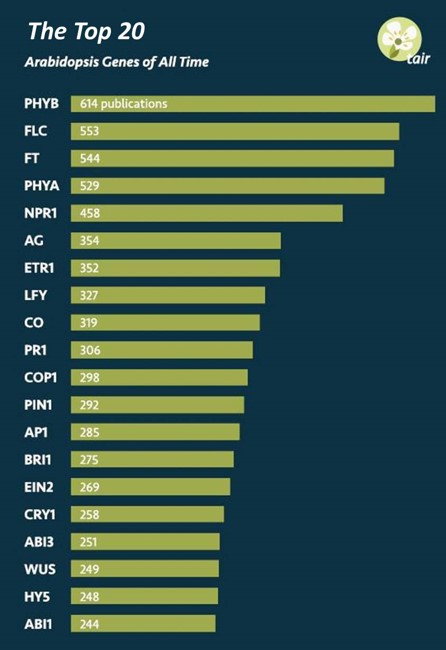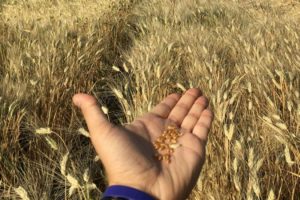Highlights of plant science 2017. Nov-Dec
The last week of the year is the time to look back and reflect. We like to take this opportunity to recognize the good work done by the plant science community. During this final week of 2017 we’ve been reminding you of some of the big stories and successes that came from our community. These stories were highly accessed through the ASPB and Plantae.org blogs, our many social media sites, and our journal websites. We hope you enjoy this look back at what has been an eventful and productive year in plant science. Check out the highlights from the first part of the year here, here, here, here and here. Special thanks to Megan Lynch for providing several in-depth spotlights for this series!
 The biggest news from the end of the year was the recognition of Joanne Chory, one of the world’s preeminent plant biologists, who was awarded a prestigious Breakthrough Prize in Life Sciences, “For discovering how plants optimize their growth, development, and cellular structure to transform sunlight into chemical energy.” Joanne is the first plant scientist to receive this award. To quote from the Salk Institute’s article, “Chory has spent more than 25 years deciphering the mechanisms that allow plants to achieve this flexibility in form, pioneering the use of molecular genetics to study how plants respond to their environments and producing major discoveries surrounding how plants sense light and make growth hormones.” Not content to rest on their laurels, Dr. Chory and colleagues at the Salk Institute are launching a new initiative to harness the power of plants to combat climate change by sequestering more carbon as suberin in their roots – read more here.
The biggest news from the end of the year was the recognition of Joanne Chory, one of the world’s preeminent plant biologists, who was awarded a prestigious Breakthrough Prize in Life Sciences, “For discovering how plants optimize their growth, development, and cellular structure to transform sunlight into chemical energy.” Joanne is the first plant scientist to receive this award. To quote from the Salk Institute’s article, “Chory has spent more than 25 years deciphering the mechanisms that allow plants to achieve this flexibility in form, pioneering the use of molecular genetics to study how plants respond to their environments and producing major discoveries surrounding how plants sense light and make growth hormones.” Not content to rest on their laurels, Dr. Chory and colleagues at the Salk Institute are launching a new initiative to harness the power of plants to combat climate change by sequestering more carbon as suberin in their roots – read more here.
Speaking of Arabidopsis, our friends at TAIR (The Arabidopsis Information Resource: https://www.arabidopsis.org/) shared a list of the 20 most studied genes (by citations) in Arabidopsis. Read about the individual genes and how the the list was curated here.

Some other stories that received lots of social media shares in Nov and Dec:
- The New York Times’ Joanne Klein wrote “How Snapdragons Beckon Bees With More Than One Color“, on a new paper on the role of small RNAs in pigmentation by Bradley et al., (showing once again that science writers are attracted to pretty flowers).
- Sánchez-León et al. described efforts to produce low-gluten, non-transgenic wheat using CRISPR/Cas9; great news for people who are gluten-sensitive.
- DNA extraction can be a time-consuming and sometimes expensive process, so we were all excited to read a method by Zou and Mason et al. which simplifies and accelerates the protocol, through absorption of the nucleic acid onto Whatman filter paper or even paper towels.
- We all know that they way we approach plant science is changing, but are we adequately incorporating those changes into the way we teach and train? This question, and possible solutions, is discussed in an important Commentary in Plant Physiology authored by many leading plant scientists: The Next Generation of Training for Arabidopsis Researchers: Bioinformatics and Quantitative Biology.
- The year draws to a close with an exciting breakthrough in Rubisco research by Aigner et al. in which the authors were able to assemble the functional enzyme in E. coli, a feat that has thwarted researchers for decades. Rubisco is the most-abundant enzyme in the world, but also notoriously inefficient. As Ars Technica reports, “We may now be able to engineer the most important lousy enzyme on the planet“.
Spotlight: Heat-resistant Non-GMO Durum Wheat (By Megan Lynch*)
 With the greenhouse effect changing which cultivars can be grown, and where and when different species can be grown, plant breeders are racing to develop varieties that can safeguard food security despite global “weirding”. As if that weren’t challenging enough, anti-GMO organizations raise fears not just in the global north but in some of the countries that will be hardest hit by climate change. Thus developing crops through marker-assisted traditional breeding is a good approach to meeting the challenge of breeding crops that can take what climate change is throwing at us, yet also avoid having a new and useful cultivar tied up in years of political wrangling.
With the greenhouse effect changing which cultivars can be grown, and where and when different species can be grown, plant breeders are racing to develop varieties that can safeguard food security despite global “weirding”. As if that weren’t challenging enough, anti-GMO organizations raise fears not just in the global north but in some of the countries that will be hardest hit by climate change. Thus developing crops through marker-assisted traditional breeding is a good approach to meeting the challenge of breeding crops that can take what climate change is throwing at us, yet also avoid having a new and useful cultivar tied up in years of political wrangling.
By identifying and using heat tolerant germplasm, the team led by Dr. Filippo Bassi & Dr. Rodomiro Ortiz bred durum wheat capable of withstanding 35 – 40 C temps. In areas where rice is grown in Mali, Mauritania, and Senegal, durum wheat could now be grown during the off-season for rice as it can not only tolerate the heat but the low night temps that prevented other staple crops from being raised. Furthermore, it’s an early variety so it can be squeezed in between the time the rice harvest finishes and rice planting starts up again. This project was recently awarded the 2017 Olam Prize for Innovation in Food Security. Read more on the International Center for Agricultural Research in the Dry Areas (ICARDA) and Food Navigator websites, and keep up to date by following the Project log on ResearchGate.
Megan Lynch* (@may_gun) has a BA in Art from UCLA and is a returning student in Biology at Pasadena Community College (Pasadena, CA, USA). She is a longtime member of California Rare Fruit Growers and hopes to go to grad school to learn fruit breeding. She’s currently studying Ceratonia siliqua and its history in California.
Without further ado, it’s time to say goodbye to 2017 and get ready to welcome in the new year. Best wishes for health, success, peace and love to all in our community and a Happy New Year!




